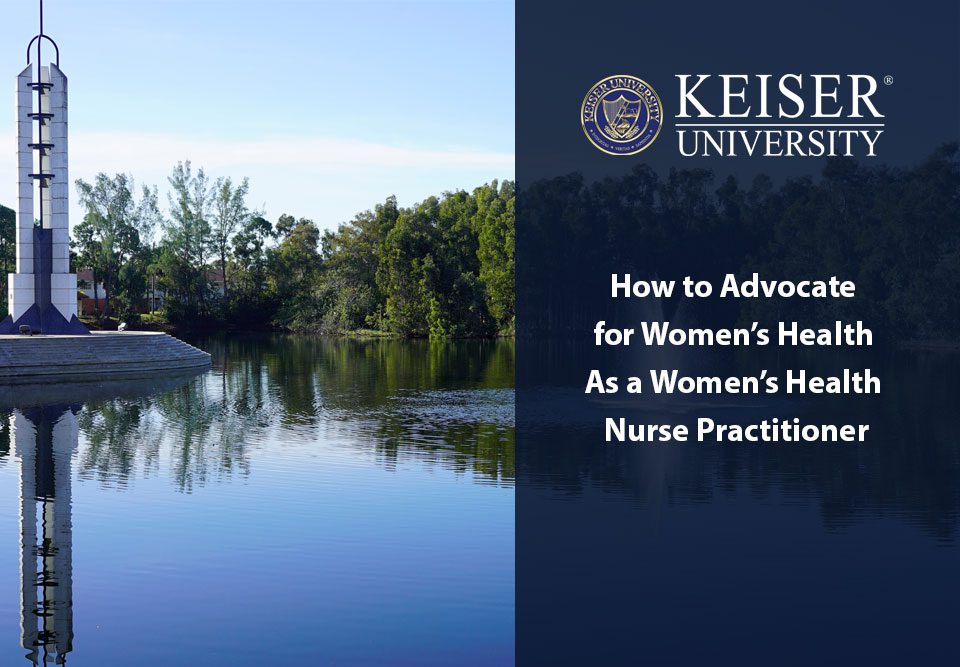Women have faced alarming barriers across the spectrum of healthcare. Many of these obstacles stem directly from biases or oversights, with women’s health issues often not taken seriously or simply regarded as secondary.
The result? Unconscionable suffering as reflected from data compiled by the Centers for Disease Control and Prevention (CDC) and other trusted resources. For example, the Morbidity and Mortality Weekly Report (MMWR) indicates that 22 percent of women experience chronic pain. Meanwhile, data from the Office on Women’s Health suggests that one in five women deal with mental health concerns. Acute issues are also common and often relate to reproduction or childbirth.
Healthcare providers have a powerful role to play in addressing and eliminating these issues, but it will take a strong commitment from the industry’s most skilled and passionate professionals to ensure that women receive the quality care they deserve. Nurse practitioners (NPs), in particular, can be amazing advocates for women’s health, with Women’s Health Nurse Practitioners (WHNPs) offering women’s health advocacy among individual patients and at the community level. Keep reading to learn why this is necessary and what it means to act as a women’s advocate.
Women’s Health Disparities
Health disparities reveal differences in quality of care, health status and long-term health outcomes among various populations. Women’s health disparities take two main forms: differences between men and women, and differences between various groups of women.
In general, women have traditionally suffered significant gender disparities, often prompted by under-representation in research as well as under-treatment related to diagnostic biases. We will provide a deeper dive into these concerns below, along with data-backed details about disparities in reproductive and maternal care.
Identifying Disparities and Inequalities in Women’s Healthcare
Alarming disparities exist in every area of women’s healthcare. These relate to maternal outcomes (such as infant mortality and postpartum health) along with rates of sexually transmitted diseases, pelvic floor concerns and more. These problems are finally beginning to receive the attention they have deserved all along, with research initiatives increasingly focusing on women’s health concerns and ongoing gender disparities.
Access to Reproductive Services, Maternal Health, and Preventive Care
Many women’s health disparities center around reproductive and maternal care. For instance, women of color face far higher rates of maternal mortality. They also face more multifaceted issues such as chronic health concerns and implicit bias often playing into these devastating outcomes.
At the community and national level, positive health outcomes should be well within reach when a comprehensive approach is established. This ensures that all women have access to a full range of preventative and reproductive services, along with strong maternal care while pregnant and during the postpartum period.
Social Determinants of Health That Impact Women’s Access
The social determinants of health (SDOH) determine how women fare both physically and emotionally throughout their lifespan. These determinants reflect the non-clinical factors in women’s homes, workplaces and communities, with everything from housing and transportation to education having a huge impact on health at every stage of life.
While SDOH are relevant to all individuals and communities, and can shape many health outcomes, a growing body of research indicates that these have a huge impact on women’s access to critical care. To note, for pregnant individuals, disparities may stand in the way of adopting healthy lifestyle habits and may even keep patients from making or showing up for prenatal appointments. Some women may be unable to access this care due to transportation obstacles, while many also lack insurance coverage or stable housing.
Promoting Access to Healthcare Services
Understanding is the first step and now that there is a sizable body of research related to women’s health disparities, interventions can be designed and implemented to ensure that women receive high-quality care. This begins with identifying and addressing top barriers that continue to keep preventative health services and other essentials out of reach.
Barriers to Women Accessing Healthcare
Many barriers stand in the way of consistent healthcare access. We have already highlighted issues related to transportation, housing and insurance, but that is only the beginning. Education can also make a world of difference, as some women simply do not realize that they face increased risks.
Unfortunately, legislative barriers also exist, although these vary dramatically based on location. Some women may be legally prevented from seeking or obtaining the targeted care they need. Others may not reside in locations with robust community health programs or health coverage and may therefore be unable to access preventative or prenatal care.
Initiatives Aimed at Improving Women’s Access to Healthcare
Although ongoing obstacles can seem difficult to overcome, many initiatives promise to improve women’s access to healthcare. Essentials include:
- Family planning services. Family planning and reproductive health programs may offer counseling or access to contraception, with the goal of empowering women to make decisions about their own bodies and the future of their families.
- Cancer screening. Many programs help women obtain necessary screenings, vaccinations and mammograms at a low cost or even free of charge. These programs often target underserved populations, with the recognition that early detection is crucial to promoting positive health outcomes in patients with cancer.
Resources and Information for Women to Navigate Healthcare
Not only do many women lack physical or economic access to healthcare services, but they also often find the healthcare system confusing or otherwise difficult to navigate. NPs can ease this frustration by providing in-depth insight into various resources or services, and details about how to access them. Many patients may also benefit from options such as:
- Clinical coordination and healthcare navigation services.
- Mobile health units and community health centers.
- Telehealth services and online patient portals.
Advocating for Reproductive Health Rights
The programs and initiatives highlighted above can make a powerful difference for patients in targeted communities, but there is also a clear need to policies that will promote better healthcare access and outcomes for all women. Similarly, advocacy efforts must also address barriers to reproductive health services so that every patient can enjoy a high standard of care.
Importance of Reproductive Rights and Autonomy in Women’s Health
Reproductive rights are fundamental to women’s health and well-being. Women need to feel confident that they can make informed decisions about their own bodies, especially as these relate to sexuality and family planning. When women feel empowered to make these critical decisions, they are better poised to pursue their personal goals and feel like respected members of our modern society.
Legislative Efforts and Advocacy Campaigns
Currently, numerous legislative efforts strive to advocate for women’s health while expanding their access to critical care. These initiatives are making waves at both the state and federal levels. Many NPs have proven strong advocates for legislative efforts such as the Menstrual Equity for All Act, the Pregnant Workers Fairness Act and the Access to Birth Control Act.
Passionate NPs are also involved in grassroots efforts advocating for expanded access to reproductive or family planning services, the protection of reproductive rights and comprehensive sexual health education.
H3: Reproductive Health Services and Resources for Women
Many women have greater access to reproductive resources or services than they realize. NPs can steer patients in the right direction by letting them know about their reproductive rights. By offering information or referrals to services that will provide further assistance with primary, preventative health care and reproductive concerns
Many services are provided directly within the NP’s office, including family planning, comprehensive prenatal care, routine gynecological exams and more. NPs can also make referrals when patients require specialized care, or they can get patients in touch with community health organizations when finances or other obstacles stand in the way.
Addressing Maternal Health Disparities
No discussion of disparities in women’s health would be complete without a deep dive into the tragic disparities in maternal health. These disparities need not persist, however, and certified nurse midwives, CNMs (who are also APRNs)regarding maternal care.
This begins with providing culturally sensitive care, with the recognition that some women are reluctant to show up for appointments or disclose sensitive information because they have been mistreated in the past. NPs can also educate and provide relevant resources (or referrals) for patients from marginalized communities.
Disparities in Maternal Health Outcomes
From maternal mortality to infant mortality and rates of birth defects or emergency cesarean birth, nearly every maternal metric available indicates disparities in outcomes between women from different backgrounds. Many issues shape these disparities, as mentioned previously. For instance, chronic health concerns can exacerbate pregnancy-specific problems, and a lack of prenatal care is always worrisome.
Maternal Mortality Rates and Access to Prenatal and Postnatal Care
Maternal mortality rates are persistently high throughout the U.S., but a wealth of evidence reveals alarming disparities and suggests that mortality rates are especially alarming among women of low socioeconomic status and among women of color. CDC data reveals a maternal mortality rate of 69.9 deaths per 100,000 live births among African American women, compared to a rate of 26.6 deaths for white women.
Limited access to prenatal and postnatal care is a top culprit. To illustrate, 19 percent of women who identify as Native Hawaiian or Other Pacific Islander (NHOPI) do not begin receiving prenatal care until they’ve reached the third trimester. In even worse scenarios, they receive no prenatal care at all.
Maternal Health Task Forces and Perinatal Quality Collaboratives
As regional networks made up of passionate healthcare professionals, perinatal quality collaboratives (PQCs) promote knowledge sharing among a variety of stakeholders. These groups employ a data-driven approach, backed by extensive research on perinatal care (including disparities) and insight into evidence-based practices that can address gaps in care.
Preventive Care and Health Promotion in Women’s Health
Preventative care plays an instrumental role in driving positive long-term health outcomes. Unfortunately, research suggests that many women lack even basic preventative care. Results from an American Academy of Family Physicians (AAFP) survey, for example, reveal that nearly half of American women have skipped preventative essentials such as checkups or vaccines in the past year, with many citing cost concerns as a main factor.
NPs can encourage patients to seek preventative care by facilitating appointment reminders and by ensuring that their patients feel comfortable and respected.
Role of Healthcare Providers and Community Organizations
Healthcare providers play a large role in promoting positive health outcomes not only among individual patients, but also for entire communities. Nurse practitioners can advocate for their patients during every appointment and, on a wider scale, by engaging in health-centered initiatives. Many NPs collaborate with public health professionals and community health organizations to get more women screened for cancer or to increase local vaccination rates.
NPs can also advocate for policies that promise to address disparities related to the social determinants of health. Examples might include improving access to health education or nutritious foods. Policymakers and other stakeholders take nurse practitioners’ insights seriously and may respond favorably if given data-backed and emotionally resonant information about the current state of women’s health.
Providing Resources for Women to Advocate for Their Own Health
Women often admit that they do not feel empowered or supported in advocating for their own health. This stems, in part, from a lack of knowledge about their own health and well-being, as evidenced by concerning results from a MDVIP and Ipsos study. 94 percent of respondents failed a Women’s Health IQ Quiz, which tested participants on concepts relevant to their own health.
NPs can help bridge this gap through health education and preventative, primary care. They can also point women in the right direction
Discover a Fulfilling Nurse Practitioner Career Path With Keiser
Do you want to empower women through your work as a nurse practitioner? Look to Keiser University for support as you take the next step in your career. Our Master of Science in Nursing, Women’s Health Nurse Practitioner program provides powerful preparation for a career you will find deeply fulfilling. Reach out today to learn more or contact a graduate admission counselor so you can take the next step.






 The instructors at Keiser University impacted my life. They believed in my ability to become a great graphic designer, regardless of how I felt about my skills. KU helped to prepare me for the real world and got me to where I am today.
The instructors at Keiser University impacted my life. They believed in my ability to become a great graphic designer, regardless of how I felt about my skills. KU helped to prepare me for the real world and got me to where I am today.
